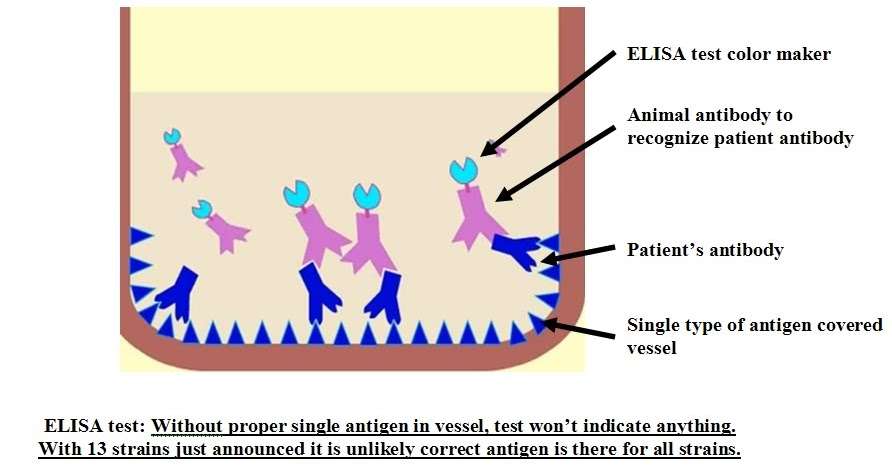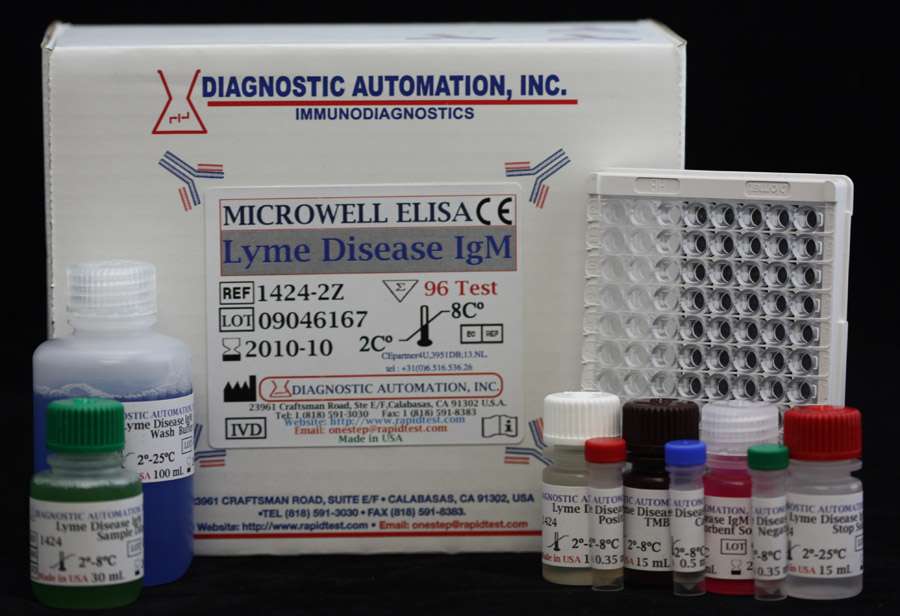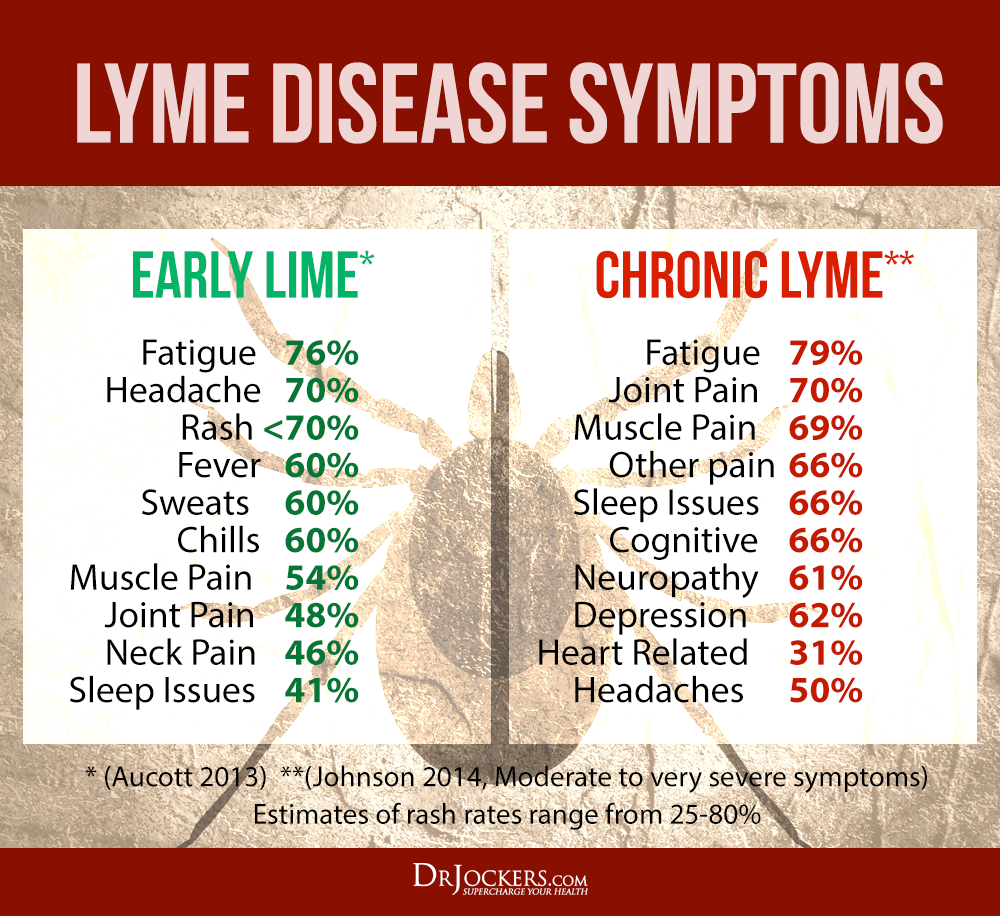Is There A Lyme Disease Test Kit
Blood collection kits are available for at-home Lyme disease testing. Lyme disease test kits can cost as less as $20 and as much as $100 or more. Using a Lyme disease test kit is as simple as pricking your finger and smearing or collecting the blood onto the kit for testing.
However, testing for Lyme disease in a more controlled environment such as a lab or clinic is preferable as qualified healthcare professionals are likely to perform a more reliable test.
Waddell L. A., et al. . The accuracy of diagnostic tests for Lyme disease in humans, a systematic review and meta-analysis of North American research. PLoS One. 2016 11: e0168613. Retrieved from
Lyme Tests: When And What
So this is a lot of information to digest and to figure out how to use. Here is a way to proceed with testing based on the above information.
1. Never do an IFA or an ELISA.
2. The first test to do is the IGenex Immunoblot IGG and IGM test. This is the best test with sensitivity of 90.9% There are a couple of drawbacks though. One is cost. At $450 US it is expensive and at this writing, it is doubtful insurance will pay. By comparison the IGenex IGM and IGG Western blot is $250 and insurance often pays. In addition, because it is not a western blot, I am not sure if insurers will recognize it when determining to cover IV antibiotics. On the IGenex order form get tests: 325 and 335.
3. As an alternative to the IGenex Immunoblot, do the Western Blot. Be sure to have it performed by a lab that tests and reports for all of the Lyme specific bands including 18, 23-25, 31, 34, 39, and 83-93. These labs include IGenex and the Lyme Disease Laboratory at Stony Brook. Note that the western blot in Canada does not test for all of these. In addition all commercial labs like LabCorp, Quest Diagnostics, PAC LAB, and PAML here in the United States use the FDA approved kit using the CDC/IDSA criteria and do not test for all of these bands either. On the IGenex order form get tests: 188 and 189.
Limitations Of Serologic Tests For Lyme Disease
Currently available serologic tests have inherent limitations:
-
Antibodies against B burgdorferi take at least 1 week to develop
-
The background rate of seropositivity in endemic areas can be up to 4%, affecting the utility of a positive test result
-
Serologic tests cannot be used as tests of cure because antibodies can persist for months to years even after appropriate antimicrobial therapy and cure of disease thus, a positive serologic result could represent active infection or remote exposure
-
Antibodies can cross-react with related bacteria, including other borrelial or treponemal spirochetes
-
False-positive serologic test results can also occur in association with other medical conditions such as polyclonal gammopathies and systemic lupus erythematosus.
Don’t Miss: My Dog Tested Positive For Lyme Disease
Serologic Tests Are The Gold Standard
Prompt diagnosis is important, as early Lyme disease is easily treatable without any future sequelae.
Tests for Lyme disease can be divided into direct methods, which detect the spirochete itself by culture or by polymerase chain reaction , and indirect methods, which detect antibodies . Direct tests lack sensitivity for Lyme disease hence, serologic tests remain the gold standard. Currently recommended is a standard 2-tier testing strategy using an enzyme-linked immunosorbent assay followed by Western blot for confirmation.
Diagnostic testing methods in Lyme disease
Lyme Disease Laboratory Tests Available At Ripl

The primary service provided by RIPL is serological testing using well-characterised and validated screening and confirmatory tests in accordance with the NICE Lyme disease guideline.
RIPL participates in regular external quality assurance exercises as an independent measure of its performance.
Details of prices and turnaround times for Lyme testing are provided in Appendix 1 of the RIPL user manual.
You May Like: Best Pemf Device For Lyme Disease
Molecular Testing For Detection Of Borrelia Species Bacterial Dna
PCR is available for Borrelia species DNA detection but is of limited value in routine testing for Lyme disease because the organism is only present in blood during the early stages of the disease and is predominantly restricted to the affected tissues.
Diagnostic molecular testing for Borrelia species DNA is available on request for relevant specimen types. Please call RIPL to discuss individual cases.
When Should I Get Checked For Lyme Disease
Generally, it is best to get tested for Lyme disease if you live where ticks are common or have recently visited such areas. Most certainly, you should get tested if you suspect that a tick has bitten you. It is important to talk to your doctor if you think you have any of the following early Lyme disease symptoms:
- A rash resembling a bulls eye on the spot where youve been bitten
- Fatigue
- Headaches
- Fever
Other symptoms dont show up immediately. Sometimes, it takes up to a few weeks or months after the tick bite to notice the following:
- Swelling on the joints or severe joint pain
- Tingling in the feet and hands
- Dizziness
- Shortness of breath
While it is okay get checked early, Lyme disease test results numbers are more authentic a few weeks after youve been bitten by a carrier-tick. Your body would have developed antibodies within that period, and that can make it easier to detect the disease.
Recommended Reading: Snow Plowing East Lyme Ct
How Do They Test For Lyme Disease
Lyme disease is best tested using two different blood testing methods. These are:
- The Enzyme-linked Immunosorbent Assay test: In a nutshell, this test will look for signs that your body is trying to fight off Lyme disease by producing antibodies. However, the ELISA test may come back negative even when a person is infected by the Borrelia burgdorferi bacteria. False-negatives can occur during the early stages of the disease, where the infected persons body has not produced enough antibodies to fight off the B. burgdorferi bacteria. For this reason, reliable diagnosis is not usually based only on the ELISA test results.
- Western Blot test: Heres a simple way to explain the western blot test without getting into all the nitty-gritty details of what it does and how it does it. Put simply, it separates the blood proteins and detects antibodies to the bacteria causing the Lyme disease. Usually, when an ELISA test comes back positive, a western blot test is performed to confirm the diagnosis.
Ideally, the CDC recommends standard two-tier testing to confirm the veracity of the Lyme disease test accuracy. Together, the ELISA and western blot tests are 99.9% accurate.
How It Is Done
The health professional taking a sample of your blood will:
- Wrap an elastic band around your upper arm to stop the flow of blood. This makes the veins below the band larger so it is easier to put a needle into the vein.
- Clean the needle site with alcohol.
- Put the needle into the vein. More than one needle stick may be needed.
- Attach a tube to the needle to fill it with blood.
- Remove the band from your arm when enough blood is collected.
- Put a gauze pad or cotton ball over the needle site as the needle is removed.
- Put pressure on the site and then put on a bandage.
Don’t Miss: Rocky Mountain Spotted Fever Vs Lyme Disease
What To Think About
- It may be hard to tell if you have Lyme disease. False-positive and false-negative Lyme disease test results are common. Many people do not make antibodies to Lyme disease bacteria for up to 8 weeks after being infected.
- Doctors often do not rely on test results alone when recommending treatment for a person who may have Lyme disease. Treatment is often based on a person’s symptoms, the time of year, having a tick bite, and other risk factors for Lyme disease.
There Are Many Types Of Lyme Tests
There are a variety of tests that can help diagnose Lyme disease by finding evidence of Lyme infection. These include ELISA, IFA, PCR, immunoblot done as a western blot, the new immunoblot with synthetic proteins, Elispot, and blood culture. Although these tests are helpful aids they are far from perfect. In this article I review each of these tests and give them a grade. With these grades in mind, I describe the way I use these tests to help decide if someone has Lyme disease.
At the end of the article I tell you what I think the best Lyme test is and why.
As you read about the tests, note that a test does not diagnose a disease. In my Seattle practice I, I did not treat a test I treated a person. Tests can be wrong. To make a diagnosis consider
- the risks of getting the infection like having a known tick bite, or a history of hiking where there are a lot of ticks that carry Lyme like in Minnesota, or a number of other risk factors,
- the symptoms,
- physical exam findings, and
- whether there is supportive testing.
Note that I said supportive testing. So the result of testing is only one part to consider in making a diagnosis. See How to Diagnose Chronic Lyme Disease. More Than A Test. for more information about this complex issue.
Don’t Miss: What’s The Cure For Lyme Disease
British Columbia Specific Information
Ticks are tiny bugs which feed on blood. For information on ticks, removing ticks, and how to avoid being bitten, see HealthLinkBC File #01 Tick Bites and Disease. You may also be interested in the HealthLinkBC File #96 Insect Repellent and DEET.
While most tick bites do not result in diseases, some can. Some of the diseases passed on by ticks include relapsing fever, tularemia, Rocky Mountain Spotted Fever , Q Fever and anaplasmosis. The most well-known is Lyme disease. For more information on Lyme Disease, visit BC Centre for Disease Control – Lyme Disease .
Learn More About Lyme Disease Diagnosis Testing

Tests can not only help to diagnose a disease, but also to manage an illness. A good test can help a doctor assess the severity of disease, estimate the patients prognosis, monitor the course of disease progression, stability or resolution, detect relapse, and select drugs or adjust therapy. Unfortunately, a test with this capability does not exist for Lyme disease. To learn more about specific tests, visit: Lyme Disease Tests.
LymeDisease.org has developed a Lyme disease symptom checklist to help you document your exposure to Lyme disease and common symptoms for your healthcare provider. You will receive a report that you can print out and take with you to your next doctors appointment that may be helpful in your Lyme disease diagnosis.
You May Like: How To Pay For Lyme Treatment
Negative C6 Elisa On Serum
Early clinical Lyme disease in the form of erythema migrans with associated history of a tick bite should be treated empirically. There is no need for testing unless there are further symptoms.
A negative ELISA result in the early stages of Lyme disease does not exclude infection. If acute Lyme disease is suspected but serology results are negative, we recommend that the test is repeated in 4-6 weeks with a fresh sample to look for seroconversion.
In patients with long term symptoms a negative ELISA test usually excludes Lyme disease as a cause of these symptoms. Information on differential diagnosis for patients with persistent symptoms and negative Lyme disease serology results is available.
How Is It Diagnosed
If youâve been outside in an area where ticks are known to live, you should tell your doctor. Theyâll also want to know about the symptoms youâre having. These details are crucial to making a diagnosis of Lyme disease.
Early symptoms that usually occur within the first month after a tick bite can include:
- Rash at the site of the tick bite that may look like a âbullâs-eyeâ
- Racing heart
- Problems with your short-term memory
Symptoms that come and go are common with Lyme disease. They will also depend on the stage of the disease.
Don’t Miss: What To Do If You Have Lyme Disease
How Is Lyme Disease Diagnosed
Though several types of tests do exist for the diagnosis of Lyme disease, the best tests for a Lyme disease diagnosis are blood tests, also known as serological tests. These tests are indirect, meaning they dont detect the infecting bacteria or its antigens but rather the antibodies an infected persons body produces in response to these antigens.
Study Design And Setting
We performed a retrospective cross-sectional study at a single pediatric institution in a Lyme disease endemic area. We included all Lyme ELISA tests ordered over the seven and a half year period between January 1, 2007 and June 30, 2014. The institutional review board approved the study protocol with waiver of informed consent.
Don’t Miss: Lyme Disease In Dogs Treatment
Investigation Of Suspected Lyme Disease
Erythema migrans is a clinical diagnosis and does not require confirmation by laboratory testing. Lyme disease is not a notifiable disease so there is no statutory requirement to notify clinically suspected cases to the local Health Protection Team.
The 2018 NICE Lyme disease guideline provides detailed advice about when a diagnosis of Lyme disease should be suspected and about which tests to use and when.
The NICE Lyme disease guideline also contains a useful summary diagram of the routine serological testing recommendations for Lyme disease.
Severity Of Lyme Disease
Misconception: B. burgdorferi infection is potentially lethal.
Science: Although Lyme disease can cause heart or brain abnormalities, there have been remarkably fewif anydeaths attributable to this infection.
LymeScience note: After this paper was published, the CDC three case studies of deaths associated with Lyme carditis, though two patients had preexisting heart conditions. While its not entirely clear if the infection caused the deaths, the CDC still reiterates, Prompt recognition and early, appropriate therapy for Lyme disease is essential.
Read Also: Can Lyme Disease Make Your Liver Enzymes Off
Lyme Blood Culture: C
A United States lab called Advanced Laboratory Services had a Lyme disease blood culture that may have good predictive value in finding Lyme infection. Note: ALS no longer offers this tests. Traditionally the problem with Lyme blood culture has been finding a substance to grow the Lyme germ. ALS has perfected a method that involves three separate steps. In the first step the blood is incubated on a special modified BSK medium. Then after 2 weeks it is transfered to a medium that has a protein matrix. As a third step a PCR techinique is use to determine if the growth on the medium is really borrelia. PCR is a techinique that finds the dna of an infection, in this case borrelia.
There is one study of this technique performed by Eva Sapi PhD and her research group. Of note the research was supported by ALS and Dr. Sapi is a member of the Research Division at ALS. This means there is an inherent bias built into the results of the research to find a positive result supporting the effectiveness of the test.
The test included 72 people who were known to have Lyme based on the very strict standards of the CDC and IDSA. There were also 50 people put in a control group who did not have Lyme. The study results found 94% sensitivity and 100% specificity.
In fact in my limited use of this test I found it missed many that I diagnosed with Lyme disease based on other tests and clinical grounds.
Elisa And Ifa: Grade F

These are screening tests to see if a person has antibodies that attach to the covering of Lyme germs. Unfortunately not only do Lyme antibodies attach but other types of antibodies made against viral infections or other germs can also attach. Because of this these are “could” tests. When these tests are positive they indicate that a person could have antibodies against a Lyme germ.
As a screening test for Lyme the ELISA and IFA are very poor. In fact numerous studies indicate an ELISA test only has a sensitivity of 50%.
Believe it or not, even with such poor reliability, the CDC and the Infectious Disease Society of America recommend this as the first test to perform on a person suspected of having Lyme disease. They recommend a two step method that includes an ELISA or IFA as step one. If one of these are positive then the second step is to perform a western blot which I describe below.
Grade: F. These tests have such a low sensitivity that they should not be used. They are an absolute waste of money even when performed by a high quality Lyme testing lab such as IGenex.
Don’t Miss: Apartments For Rent In East Lyme Ct
Interpret Laboratory Results Based On Pretest Probability
The usefulness of a laboratory test depends on the individual patients pretest probability of infection, which in turn depends on the patients epidemiologic risk of exposure and clinical features of Lyme disease. Patients with a high pretest probabilityeg, a history of a tick bite followed by the classic erythema migrans rashdo not need testing and can start antimicrobial therapy right away.
References Choosing A Test
You May Like: Lyme Research And Healing Center